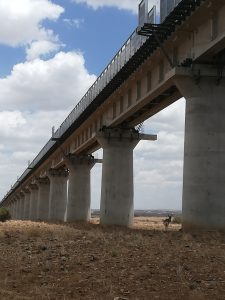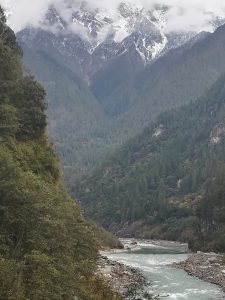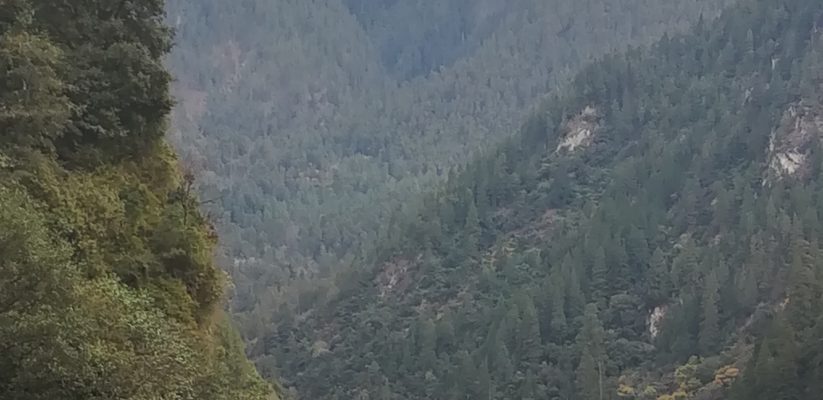Written by Ross Anthony
For the past two centuries, a crucial tenant of western proselytising has been liberty by way of free markets – by force, if need be. Given today, most of the world operates according to principles of profit-based production, with Asian incomes rapidly edging closer to those of Europe and North America, we might conclude that this 19th century utopia has come to pass. And yet, as principles of infinite accumulation rapidly accelerate atmospheric warming and ecological fragmentation, the stellar successes of Asia – China in particular – has become, simultaneously, a signifier of planetary anxiety (Anthony 2019: 104).
Several decades ago, Anthropologist Gregory Bateson came up with the now de-bunked theory of the ‘double bind’ to explain schizophrenia (1987, 199). The illness, he believed, stemmed from situations in which a figure of authority encourages a subject to carry out an action, with the knowledge that they would be punished for it. Thus, correctly responding to one message results in the failed response to another message. Western ambivalence toward China reflects this logic to some extent: ‘Congratulations on your stellar integration into the global market system, now please stop!’.
The fact that China’s trajectory inspires many in the Global South, that its commodity chains and infrastructural networks now join Euro-America’s in criss-crossing the region, compounds angst in some quarters. It is not China, per se which is the basis of this discontent. Rather, given its size and speed of development, it serves as the metonym of the broader post-Cold War transition of the Global South from post-imperial and emancipatory, to one or other variety of post-modern and mercantile. Dubbed Capitalism, Alone (2019) by Branko Milanovic, China is not only a metonym of planetary market saturation but equally a metonym of ecological planetary finitude.
While in some respects, such dis-ease reflects what Litzinger and Yang refer to as ‘Yellow Eco-peril’, at a broader level, as they point out, it is symptomatic of much vaster, globalized processes of production and consumption (2020). Nothing points to this more than China’s own extraterritorial expansion of capital and its eager endorsement by swathes of the Global South.
China’s transnational infrastructural development programme, the Belt and Road Initiative (BRI), is instructive of this process. While not on par with European colonisation, there is nonetheless a rhyming between the two in terms of economic and ecological limits. It has been argued, for instance, that American colonisation offered European states a way out of growth cul-de-sacs, opening what John Richards refers to as an ‘unending frontier’ of timber, fur, fish and agricultural land, all of which were dwindling domestically (2003). While today, East Asian markets suck up species abroad which have been decimated at home, rhino, elephant, pangolin and the like, there are more 21st century displacements too: vast domestic surpluses of steel, cement, plate glass, electrolytic aluminium, coal and petrochemicals, pressed into the service of Chinese construction companies operating abroad.
This necessity of geographical expansion and restructuring to keep profits flowing, encapsulated in David Harvey’s term, ‘the spatial fix’ (2003: 116), has gone hand in hand with domestic environmental improvements. In contrast to the ravages of previous decades, today, China, albeit unevenly, shutting down polluting industries, reforesting, and committing to global climate change goals. This trajectory resembles something akin to an environmental Kuznets curve, which predicts that environmental quality deteriorates at the early stages of economic development/growth and subsequently improves at later stages.
One consequence of this movement – a process parts of the western world have undergone to some extent – is the outsourcing of environmentally deleterious portions of the economy. Industrialising Asia has been a site of such outsourcing itself for some time but is now squeezing the balloon elsewhere. Within the Chinese context, improvements at home have, at times, occurred with declines abroad, ranging from an international increase in deforestation, to the outsourcing of coal technology abroad. While China appears to be making some degree of environmental transition at home, most countries in the Global South are only beginning to industrialise.
At the other end of the network, many of the elites in the ‘developing world’ actively solicit international investment, not least of all China’s. Motivations range from sincere attempts at economic upliftment on one hand, and patronage opportunities on the other. While infrastructure projects can make significant contributions to people’s lives, they nonetheless radically alter ecological systems, in spite of even the most sophisticated environmental mitigation. This is the contradiction at the heart of BRI projects as well as the past forty years of the Chinese ‘miracle’: so many projects at once offer great prosperity to society – a form of development to which many citizens, even agricultural ones, now openly aspire – while simultaneously posing grave threats to the environment. This is exacerbated in the equatorial regions of the Global South where the bulk of the earth’s biodiversity subsists. Seemingly, no degradation, no prosperity.
Take the case of Kenya as an example. New roads and railways are often deliberately built through wilderness areas due to cost. Instead of the state having to buy up additional individual land parcels, relevant ministries cut deals with the various environmental services and, voila!, land is excised from gazetted forests and national parks. The new Standard Gauge Railway (SGR), built by China Road and Bridge Corporation, bisects mangrove wetlands in Mombasa, Tsavo National Park, Nairobi National Park and Ololuua Forest (fig 1.). Despite NGO campaigns, many projects have popular support, not least the SGR which saves thousands of citizens the back-breaking, hair raising bus ride between Mombasa and Nairobi.

Fig 1. The SGR railway line running through Nairobi National Park. Source: author.
The process of ecological fragmentation is echoed elsewhere in Kenya: thermal energy developments at Hell’s Gate National Park; the Southern Bypass cutting through Ngong forest; the LAPSSET (Lamu-South Sudan-Ethiopia) corridor set to bisect sensitive animal migratory routes in Northern Kenya and the Mau Mau Highway, cutting directly through the Aberdare Forest, home to the mountain bongo antelope, of which there are less than a thousand individuals left. More broadly, similar effects are anticipated across sub-Saharan Africa. Laurence et al (2015) argue that of 33 infrastructure corridors, planned or existing, over 400 protected areas will ultimately be bisected.
These immediate impacts are complimented by deferred impacts – subsequent secondary and tertiary roads, spread of agriculture into frontier zones, urbanisation and industrialisation which sprout from primary projects. Notoriously difficult to determine, it remains to be seen what deferred impacts will play out in countries such as Kenya. But history is instructive. The old colonial British railway connecting Mombasa to Uganda, for instance, radically altered the Kenyan landscape, resulting in around a 30% loss in forest by the time the British left in 1963 (Murphy 2012: 2).
It is also informative to turn to China itself where, for example, the early 2000s ‘Develop the West Campaign’ (Xibu Dakaifa 西部大开发) has seen a host of rail and road projects penetrate deeper into the mountainous west. In Sichuan and Yunnan for example, such projects and subsequent settlement have led to wilderness areas breaking up into smaller and smaller fragments (Liu et al. 2019). This process continues today where, for example, a second railway to Tibet, by way of the city of Chengdu, is currently being built, opening up ecologically isolated valleys of Southeast Tibet to the populous Red Basin (fig 2.).

Fig 2. Pome (Tib. sPo yul; Ch. Bomi 波密), Tibetan town in Po Tsangpo valley where Sichuan-Lhasa railway will run through. Source: author.
While research on particular BRI projects is important, it is equally vital to toggle between this granular perspective and the deep-time dynamic of capitalism as part and parcel of the earth’s ecosystems – what Jason Moore refers to as capitalism in nature (2015). From this broader perspective, extractive centres shift to peripheries, which in turn become their own centres, drawing on new peripheries. The Chinese version at once proceeds, but also interacts with the Euro-American configuration, as it does with other emerging centres such as India, Brazil and Turkey. In this reading, anxiety around China’s ascension is not only geopolitical and commercial, but, more existentially, an anxiety around the finitude of modes of life and the capitalist system itself. Negotiating such limits will surely be on of the biggest challenges of the 21st century.
Ross Anthony is a research fellow at the Department of Modern Foreign Languages at Stellenbosch University. He is the editor, with Uta Ruppert, of the volume Reconfiguring Transregionalisation in the Global South: African Asian Encounters (Palgrave 2020). He is currently working on a monograph on the Humanities and extinction. Featured image shows Pome (Tib. sPo yul; Ch. Bomi 波密), Tibetan town in Po Tsangpo valley where Sichuan-Lhasa railway will run through. Source: author.
- TV Drama Discourse on Stay-at-home Fathers in China: Super Dad & Super Kids - January 28, 2022
- Freud and China - January 20, 2022
- “Cultural China 2020″—A Different Take on China - January 7, 2022

[…] second piece comes from Ross Anthony and takes a look at how, at a time of accelerating atmospheric warming and ecological […]